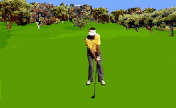By Jack Moorehouse
Here’s a golf tip that’s proven effective more times than not: If you want to cut strokes from your golf handicap, learn to hit shots that hit the green and stick. That’s right. Learn to hit shots that stick. They can save you anywhere from one to two strokes per hole. More depending on how far away the ball bounces from the pin. If the ball really takes off after it hits, look out.
The key to hitting shots that stick is backspin. Golfers need to apply backspin to balls more than ever before. Faster greens, tighter pin positions, more forced carries, and lower-lofted wedges and short irons demand it—the USGA’s new ruling on wedge grooves not withstanding. This ruling affects both professional and weekend golfers alike. What’s more, learning to control backspin helps slash your golf handicap.
The Backspin Equation
You probably already make swings capable of producing shots with good backspin—even if you don’t do it on purpose. But just your swing alone isn’t enough. To complete the backspin equation, you must add the right type of ball and the right face grooves on your wedge. Nail these factors and your spin potential increases dramatically.
To generate backspin: (1) position the ball back of center one to two ball widths, (2) place your hands ahead of the clubhead, and (3) accelerate through impact. The more you accelerate through impact, the more spin generate and the more likely your shots will stick. Combining the right swing with the right ball and the right type of groves is how many instructors teach this skill in golf lessons.
Ball Construction Is Key
Ball construction is also a key to generating backspin. To hit backspin sufficient enough to have a ball stick, play a ball with a cover soft enough to be engaged by the grooves in the clubface. Generally speaking, urethane covers are softer than Surlyn covers. Urethane and Surlyn are the principal materials from which most covers are made.
While balls with Surlyn covers are longer off the tee, balls with urethane covers help control backspin better. They’re also more expensive balls. If some one takes golf lessons from us and they’re not using a ball with a urethane cover, we figure they just don’t know about the benefits of doing so.

Grooves Are Also Key
Your wedge’s face grooves are also key to adding spin. A high-producing wedge must have aggressive enough face grooves to engage the ball. New grooves spin more than old grooves and clean grooves spin more than dirty ones. Also, the sharper the groove edges, the better they grab the ball’s cover and produce spin. More importantly, box grooves are better than U-grooves and V-grooves and worn out grooves of any shape.
The USGA recently made a rule change that can affect your choice of wedges with box grooves. This new ruling downsizes volume and limits edge sharpness for all grooves manufactured after January 1, 2010, so they’re equal to or less than the previously approved V-groove dimensions. If you’re an amateur, you have a choice of which grooves to play until at least 2024. On the other hand, if you buy a wedge manufactured after last January, it must have grooves with spin performance at or below V-groove levels.
If you want to hit shots that stick, learn to add backspin to your ball. The keys to adding backspin are using the right setup and swing, a ball with a urethane cover, and a wedge with the right grooves. These keys affect all shots that hit the green. Getting shots to stick when they hit can chop two to three strokes from your golf handicap.
This entry was posted on Monday, August 23rd, 2010 at 12:58 pm and is filed under Golf Articles. You can follow any responses to this entry through the RSS 2.0 feed. You can leave a response, or trackback from your own site.



